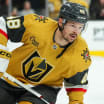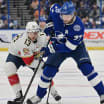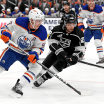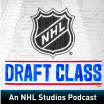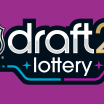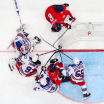Toronto Maple Leafs rookie center Auston Matthews and Winnipeg Jets rookie right wing Patrik Laine have captivated us all season. Many believe one of the two will win the Calder Memorial Trophy as the NHL's top rookie.
Only two rookies since 2000 have scored more goals in their first season in the League than Matthews (38 goals) and Laine (34 goals): Alex Ovechkin of the Washington Capitals scored 52 goals as a 20-year-old in 2005-06 and Pittsburgh Penguins captain Sidney Crosby scored 39 as an 18-year-old that season.
Comparison: Auston Matthews vs. Patrik Laine
Former NHL GM, analyst Craig Button breaks down rookies in six categories
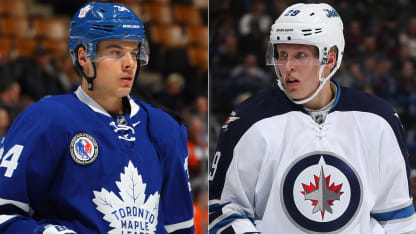
With less than one week remaining in the regular season, NHL.com recruited TSN resident director of scouting, analyst and former NHL general manager Craig Button to aid in a comparison between Matthews and Laine in six categories.
1. Shooting:Matthews has averaged 3.40 shots per game and Laine 2.80. Laine has made a habit of setting up for the big one-timer from the left circle on the power play, with an average shot length of 39.9 feet. Matthews prefers creating chances in tighter spaces near the goal with an average shot length of 24.9 feet.
Button: "Laine has that ability to freeze goaltenders because not only can he hit the spot on the net, but it's disguised so well. It's not just how quick he gets it off but it's the velocity. So while you look at the number of shots between the two players and see the difference, I think right now Laine is ahead when you take into account an ability to score and threaten. He's got a release like Mike Bossy."
2. Playmaking:The Maple Leafs generate 50.50 percent of all shots attempted at even strength when Matthews is on the ice, a good indicator for explaining how great a playmaker he's been this season. The Jets generate 47.58 percent of the shot attempts when Laine is on the ice. Matthews is fourth among all rookies with 20 primary assists; Laine ranks eighth with 13.
Button:"I think Laine's playmaking is underrated but that Matthews has more awareness of a play that can't work at this point in his career. Laine is going to try some things that aren't going to produce real good-quality chances, and maybe turnovers. I think Matthews has a better grasp of that play that isn't a wise one to try to make."
3. Hockey sense: Matthews and Laine are on another level as teenage players when it comes intelligence with the puck. Each can make can make split-second decisions while going full speed. They can pull fans out of their seats whenever they possess the puck and begin that surge through the neutral zone.
Button: "Laine has unbelievable offensive creativity in terms of what's there, and he's taken full advantage of who he plays with and the situations he's been given. But Maple Leafs coach Mike Babcock has put a lot of trust in Matthews, a center, playing alongside two other rookies. He's basically saying, 'I'm not worrying about supporting Matthews. I'm worried about who can take advantage playing with Matthews,' and they are in the playoff hunt. Babcock trusts Matthews, and that speaks volumes about Auston's hockey sense."
4. Skating: Matthews and Laine have improved their skating with and without the puck in each zone. Winnipeg coach Paul Maurice and Babcock have praised their rookies for their determination in the defensive zone as well.
Button: "It's coming around for Patrik, but I think Auston has a little bit of an edge because of his leverage in tight and those body-on-body battles. In the open ice they both can skate, both are quick and both are fast. Matthews really holds his ground, holds his leverage in those tight spaces and areas when someone is leaning on him. Laine has great leg and core strength and in the open ice both are terrific. But where space is limited and you have to carve out a lane, Matthews carries that advantage."
5. Physicality: Laine (6-foot-5, 206 pounds) has averaged 1.1 hits per game; Matthews (6-3, 216) has averaged 0.2. Physicality, however, isn't based solely on how many hits a player has.
Button: "One thing I look for in young players, even if they're light, is if they allow themselves to be pushed out of the game. Do they have a resistance? Matthews and Laine will get into the hard areas, going body on body. When they're confronted with obstacles of resistance they're trying to push through. They have an attitude like, 'I don't see the obstacles in front of me; I just see how I need to get to the other side.' As a center, Matthews doesn't get as many hit opportunities because he has to be in more areas of the ice and has more responsibility. When on the boards, trying to get in and trying to separate, a winger (Laine) has a better chance of that."
6. Leadership: No matter how graceful a goal or the number of goals scored in a game, Matthews and Laine have carried themselves as true professionals. It's in the way they celebrate with teammates or their humble demeanor during the postgame media scrum. Matthews and Laine have shown they have the ability to lead, not only through their actions on the ice but in the way they credit those around them.
Button: "I think the biggest thing for young players is knowing you have to lead yourself before you can lead others. Matthews and Laine are tremendous leaders of themselves. Mistakes happen, but they don't belabor those errors. They want to make a difference in the game, make a difference when it's hard. I think they've both set an example of how to carry yourself and exhibit leadership skills to your teammates and everyone else in the League."
Head-to-Head comparison
(Games through April 2)
Matthews
Games: 77
G-A-Pts: 38-28-66
Shots on goal: 262
Avg. ice time: 17:38
SAT%: 50.50
Hits: 19
\Goals created per game: 0.37
SAT: plus-22
Points per 60 minutes (all situations): 2.91
Laine
Games: 70
G-A-Pts: 34-28-62
Shots on goal: 196
Avg. ice time: 17:57
SAT%: 47.58
Hits: 79
\Goals created per game: 0.37
SAT: minus-85
Points per 60 minutes (all situations): 2.96
*- information courtesy Hockey-reference.com


